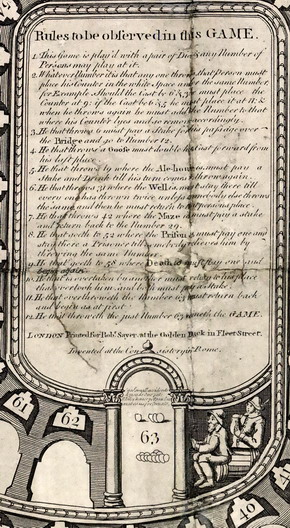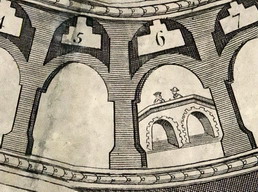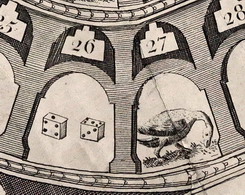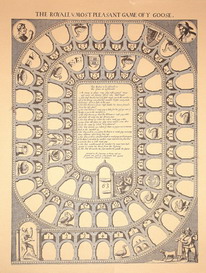Giochi dell'Oca e di percorso
(by Luigi Ciompi & Adrian Seville)
(by Luigi Ciompi & Adrian Seville)

|
Giochi dell'Oca e di percorso
(by Luigi Ciompi & Adrian Seville) |

|
 |

Torna alla ricerca giochi (back to game search) |
 |
| Royal (The) and most Pleasant Game of the Goose | ||
| London: Printed for Robt. Sayer, at the Golden Buck in Fleet Street. Invented at the Consistory in Rome. | ||
 |
Versione stampabile
 |
Invia una segnalazione

|
              |
primo autore: | Non indicato |
| secondo autore: | Sayer Robert | |
| anno: | 1725/50 | |
| luogo: |
Inghilterra-Londra |
|
| periodo: | XVIII secolo (3°/4) | |
| percorso: | Percorso di 63 caselle numerate | |
| materiale: | carta (paper) (papier) | |
| dimensioni: | 480X360 | |
| stampa: | Acquaforte (taille-douce) (ecthing) | |
| luogo acquisto: | ||
| data acquisto: | ||
| dimensioni confezione: | ||
| numero caselle: | 63 | |
| categoria: | Oca | |
| tipo di gioco: | Gioco Oca Classico (63 caselle) Verticale | |
| editore: | Sayer Robert | |
| stampatore: | Printed for Rob.t Sayer at the Golden Buck in Fleet Street (1750). (by John Bowles, 1725) | |
| proprietario: | Collezione A. Seville | |
| autore delle foto: | A. Seville | |
| numero di catalogo: | 926 | |
| descrizione: |
Gioco di 63 caselle numerate, spirale, antiorario, centripeto. REGOLE: al centro. CASELLE: mute. NOTA: Vedi esemplare Arch. n°1441 e Arch. n°2366. REFERENZA 1 "The Royal and most Pleasant Game of the Goose". (V&A Museum). Physical description Design: copper plate engraving, uncut and unmounted; elongated spiral, anti-clockwise, with corner illustrations and a central panel which contains the rules N°of squares: 63 Squares illustrated: 21 Square numbering: all Squares titled: some Subject of starting square: archways Subject of ending square: balls with writing above Place of Origin: London Date: ca. 1750 Object history note: a weak impression of the game but otherwise in good condition. Historical context note Rewards: forward movement, extra turns, taking of counters Forfeits: backward movement, missed turns and payment of counters; including starting again N°of Players: any number Equipment required: dice, counters - 12 for each player Rules: 1. This game is play'd with a pair of dice and any number of Persons may play it. 2. Whatever number it is that any one throws that Person must place his Counter in the white space under the same number, for Example should the Cast be 6 & 3 he must place the Counter at 9; if the Cast be 6 & 5 he must place it at 11; & when he throws again he must add the Number to that where his Counter lies and so remove accordingly. 3. He that throws 6 must pay a stake for his passage over the Bridge and go to No. 12. 4. He that throws a Goose must double his Cast forward from his last place 5. He that throws 19 where Ale House is must pay a stake and drink till his turn comes to throw again. 6. He that throws 31 where the Well is must stay there till every one has thrown twice unless somebody else throws the same, and then he must return to that person's place. 7. He that throws 42 where the Maze is must pay a stake and return back to 29. 8. He that goeth to 52 where the Prison is must pay one and stay a Prisoner till somebody relieves him by throwing the same Number. 9. He that goeth to 58 where Death is must pay one and begin again. 10. He that is overtaken by another must return to his place that overtook him and both must pay a stake. 11. He that overthroweth the Number 63 must return back and begin as at first. 12. He that throweth ust Number 63 wineth the game. *Each player starts with 12 counters and pays his debts into a pool which becomes the winnings. The saying above the jester reads:- Fortune is the Changling Diety of Fools, Against ill luck all cunning foresight fails, Whether we're wise or no it nought avails. The saying above square 63 reads:- On not small Accidents Depend our fat...Whiule Chance not Prudence makes us fortunate. Playing surface shows an anticlockwise elongated spiral, with numbered compartments 1 to 63 showing archways. There are corner illustrations and the central panel which contains the rules of play. The title is across the top of the game. The lower left corner is the starting square and show a drawing of a jester with 6 lines of text above. The lower right corner shows a man, a woman and a dog. The upper left corner shows a medallion with the words JONATHAN WILD THIEF TAKER GENERAL OF GREAT BRITAIN; the upper right corner shows another medallion with the words JACK SHEPHERD DRAWN FROM LIFE. Some of the compartments show illustrations - 6 Bridge; 9, 11,26 Dice; 14,18,45 Goose swimming; 19 House/Inn; 23,27,32,36,41,50,54,59 Goose on land; 31 Well; 52 House/Inn; 58 Skeleton; 63 Balls with writing above, which is so small and pale that it is unreadable. The square to the right of 63 show two men, one of which is drinking. *The example of this game shown in the RC Bell books was published by John Bowles & Son at the Black Horse in Cornhill. It is exactly the same as this example except for the publisher's name and address. There is no obvious connection between the two or between Overton and Bowles; perhaps Sayer or Overton obtained the Bowles copy as it was out of date by the 1745-50 period. Although the Overton example is essentially the same in design, it does have major changes, whereas the Sayer does not. Rules placement: in the centre panel Attribution Note: printed for Robt. Sayer, at the Golden Buck in Fleet Street. Invented at the Consistory at Rome. REFERENZA 2 WHITEHOUSE, Francis Reginald Beaman, (pag. 55-56): ROYALL & MOST PLEASANT GAME OF THE GOOSE. (Not dated.) “Invented at the Consistory in Rome and are printed and sold by H. OVERTON at Ye White Horse without Newgate where all sorts of Fine Prints and Maps are Sold and Framed at Reasonable Rate." In black and uncoloured from a copper plate, the impression of which shows clearly, 18 ½ in X 14 ¼ in; the paper itself is 21 in X 16 5/8 in, and conforms to the usual vertical watermarked lines 1 inch apart with horizontal ones 20 to the inch at right angles; a coat of arms completes the watermarking. The game is a race running anti-clockwise to Space 63, but "Hee that overthroweth ye number 63 must turn back againe & Counte his throw from the Begining". “He that throweth ye last number 63, wineth the game." The rules, 12 in number, state that “a Paire of Dyce” are required. Most of the 63 spaces are blank, but 13 have geese which “Duble his Chance Forward", others e.g. 58, “Where Death is must pay one and begin again". ' This is the game mentioned in Oliver Goldsmith’s Deserted Village, published 1770: “The Pictures plac’d for ornament and use, The Twelve good rules, the Royal Game of Goose." This also is that game of Goose to which both John Jefferys in his Play of Geography, 1759, and Mrs. Newbery’s Game of Human Life, 1780, refer. Another game exactly similar in design was published by Robt. Sayer at The Golden Buck, Nr. Serjeant’s Inn, Fleet Street: like Overton's, it too is not dated. The fact that Jefferys instructed the players of his game in 1759 to “proceed as in the game of Goose" suggests the latter being widely known and without any definite evidence, 1750 may be accepted as a probable publishing date. This is the earliest of all table games of this character. Author's copy is uncut and even unfolded-where has it lain all the 200 years since it was sold at “Ye White Horse without Newgate”? Forty years were then still to pass until, with the fall of the Bastille in 1789, the Kingdom of France ended with the execution of Louis XVI in 1793. REFERENZA 3 "... The ROYAL and most PLEASANT GAME of the GOOSE. London: printed for Robt. Sayer at the Golden Buck in Fleet Street [c. 1750, reprint of an original from c. 1725]. Copper engraving, 48 × 36 cm. The original of this game was “printed for and sold by John Bowles at the Black Horse in Cornhill” [London] (1). The game is characterized by its portrait medallions. On the left is “JONATHAN WILD Thief Taker General of Great Britain,” and though his impressive title was self-granted, he was well regarded and was consulted in 1720 by the Privy Council on how to deal with crime in London. Only later was it discovered that Wild himself was largely responsible for organizing much of the criminal underworld. On the right is “JACK SHEPHERD Drawn from the Life,” in heavy handcuffs. Jack Shepherd - by tradition, the model for Tom Idle in William Hogarth’s Industry and Idleness series - was a notorious house burglar. He was, through Wild’s efforts, arrested, convicted and hanged in 1724. Wild’s true criminal nature was revealed soon after and he was hanged in 1725. The game itself differs slightly but significantly from the John Overton print (Arch. n°1441). Although in most respects it is a classic Game of the Goose, it lacks the geese on spaces 5 and 9. It is not clear why this change was made, but a possibility is that it was to differentiate the game from Overton’s." -nota (1): John Bowles (1701-79) was a map and print seller, whose family operated a prolific business producing maps and prints in the 18th century. Robert Sayer (1725? - 94) was active at the Golden Buck from 1748 - 66. (Adrian Seville) Exhibitions: - "The Royal Game of the Goose four hundred years of printed Board Games". Exhibition at the Grolier Club, February 23 - May 14, 2016 (Prof. Adrian Seville). |
|
| bibliografia: |
1) BARLETTA, Gabriele: "Sermones fratris Gabrielis Barelete tam quadrigesimales, quam de sanctis noviter impressi." (pubblicati per la prima volta a Brescia da Giacomo Britannico l'11 nov. 1497 i quadragesimali ed il 13 gennaio 1498 gli altri.) Impressi Lugdunum per Magistrum Nicolaum Lupi, 1507. 2) CARRERA, P. : "Il Gioco degli Scacchi", Militello, page 25, 1617. 3) BROWNE, Sir Thomas: "Pseudodoxia Epidemica, ChXII", 1650. 4) LA MARINIERE, de: "La Maison Academique: contenant un recueil general de tous les jeux divertissans pour se rejouyr agreablement dans les bonnes compagnies", par le sieur D.L.M. [de La Marinière]. A Paris: chez Robert de Nain et Marin Leché, M.DC.LIV (1654) 5) MENESTRIER, C. F. : "Bibliotheque Curieuse et Instructive", Trevoux, page 196, 1704. 6) D’ALEMBERT et Alii: "Encyclpédie Methodique: Mathematiques" (con "Dictionnaire de Jeux, faisant suite au Tome III des mathématiques") Ed. Panckoucke e Agasse, Parigi 1792. 7) VINCK, Eugène, Baron de: "Iconographie du Noble Jeu de l’Oye. Catalogue descriptif et raisonné de la Collection de Jeux formé par le Baron de Vinck". 126 Jeux du XVIIIe au débùt du XIXe siècle. FR. J. Olivier Libraire, 11 Rue des Paroissiens, Bruxelles, 1886. 8) CULIN, S. : "Chess and Playing Cards", University of Pennsylvania, pages 843-848, 1895. 9) GRAND-CARTERET, John: "Les jeux d'oie". In "Vieux papiers, vieilles images. Cartons d’un Collectionneur", Le Vasseur&C.ie Parigi (pp. 257-276), 1896- 10) BLAU, J.L. : "The Christian Interpretation of the Cabala in the Renaissance", Columbia University Press,1944. 11) D’ALLEMAGNE,H. R. : "Le Noble Jeu de l’Oie", Paris, Libraire Gruend, 1950. 12) AMADES, Joan: "El Juego de la Oca", Bibliofilia Vol.III, Editorial Castalia, Valencia, 1950. 13) WHITEHAUSE, F. R. B. : "Table Games of Georgian and Victorian Days", London, Peter Garnett, 1951. 14) MURRAY H. J. R. : "A History of Board Games Other Than Chess", Oxford University Press, pp 142-143, 1952. 15) NEGRI, Ilio – VERCELLONI, Virgilio: "I giochi di dadi d’azzardo e di passatempo dei gentiluomini e dei pirati". Introduzione di Caterina Santoro, Lerici Milano (Contiene 125 giochi).1958 16) HANNAS, L. : "The English Jigsaw Puzzle", London, Wayland, page 115, 1972. 17) HIMMELHEBER, G. : "Spiele – Gesellschaftspiele aus einem Jahrtausend", Deutscher Kunstverlag, 1972. 18) Catalogo Mostra: "Il dilettevole giuoco dell’oca". Museo Civico Lodi (catalogo redatto da Silvia Mascheroni e Bianca Tinti), 1980. 19) MASCHERONI S. and TINTI, B. : "Il Gioco dell'Oca", Milano, Bompiani, 1981. 20) GIRARD A. R. - QUETEL, C. : "L'histoire de France racontée par le jeu de l'oie", Paris, Balland/Massin, 1982. 21) MILANO, Alberto: "Antichi giochi su carta". In "Come giocavamo. Giochi e giocattoli 1750-1960". Bonato Patrizia - Franzini Paolo - Tosa Marco (curatori della mostra), 1984. 22) VON WILCKENS, L. : "Spiel, Spiele, Kinderspiel (exhibition catalogue)", Germanisches Nationalmuseums, Nuernberg, page 17, 1985. 23) PREAUD, M. - CASSELLE, P. - GRIVEL, M. - LE BITOURE' C.: "Dictionnaire des éditeurs d'estampes à Paris sous l'Ancien Régime". Promodis,1987. 24) HUFMANN C.C. :"Elizabethan Impressions: John Wolfe and His Press", New York, AMS Press; 1988. 25) DEPAULIS, Thierry: "Sur la piste du jeu de l’oie". In "Le Vieux Papier", fascicolo n°345, ottobre 1997, Parigi. 26) DOMINI, D. : (in)"La Vite e il Vino" (exhibition catalogue), Fondazione Lungarotti, pages 37-38, 1999. 27) DEPAULIS, Thierry: "Sur la piste du jeu de l’oie II". In "Le Vieux Papier", fascicolo n°352, (pag. 269-270) aprile 1999, Parigi. 28) Catalogo Mostra: “Le jeu de l’oie au musée du jouet”, Ville de Poissy 2000. 29) Catalogo Mostra: "Il Gioco dell’oca nei tempi", Pro Loco Mirano, Ed. CentroOffset srl - Mestrino, Padova 2001- 30) ZOLLINGER, M. : "Zwei Unbekannte Regeln des Gansespiels", Board Game Studies 6, Leiden University, 2003. 31) SEVILLE, Adrian:"Tradition and Variation in the Game of Goose", in: "Board Games in Academia III", Firenze, Aprile 1999. (aggiornamento del 2005). 32) BUIJNSTERS, P.J. and Buijnsters-Smets,L. : "Papertoys", Zwolle, Waanders, 2005. 33) SEVILLE, Adrian: "The sociable Game of the Goose". In "Board Games Studies Colloquia XI", 23-26 Aprile 2008, Lisbona - Portogallo. 2008. 34) MARTINEZ Vázquez de Parga, María José: "El Tablero de la Oca" 451 Editores (Casa 451), Zaragoza, Spagna, 2008. 35) DEPAULIS T. - ZOLLINGER M.: "Le jeu de l’oie". In: Annemie Buffels (ed.). "L’art du jeu: 75 ans de Loterie Nationale". Bruxelles, Fonds Mercator / Loterie Nationale, 2009, pag. 70-77. 36) MILANO, Alberto - CRIPPA, Giuliano: "GIOCHI DA SALOTTO. GIOCHI DA OSTERIA nella vita milanese dal Cinquecento all'Ottocento". Catalogo Mostra Palazzo Morando, Via S.Andrea 6 Milano. (Con la collaborazione di Giuliano Crippa). Edizioni Gabriele Mazzotta, 2012. 37) SEVILLE, Adrian: "The Royal Game of the Goose four hundred years of printed Board Games". Catalogue of an Exhibition at the Grolier Club, February 23 - May 14, 2016. 38) SEVILLE, Adrian: "The Medieval Game of the Goose: Philosophy, Numerology and Symbolism". In: "From cardboard to keyboard". Proceedings of Board Games Studies Colloquium XVII; Eddie Duggan & David W. J. Gill (Eds.) Associaçao Ludus, Lisbona 2016. 39) GIAMMINUTI, Patrizia: "Il Gioco dell’Oca: una proposta iconografica". In "Ludica. Annali di storia e civiltà del gioco", 23, 2017. 40) SEVILLE, Adrian: "The Cultural Legacy of the Royal Game of the Goose. 400 years of Printed Board Games". Amsterdam University Press, 2019. |
|
| "Tradition and Variation in the Game of Goose" (A. Seville) | ||
Vai alla ricerca giochi Vai all'elenco autori